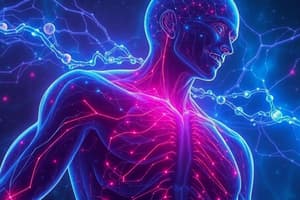Podcast
Questions and Answers
What is the primary mechanism of injury in Myasthenia Gravis?
What is the primary mechanism of injury in Myasthenia Gravis?
- IgG antibodies destroy post-junctional nicotinic ACh receptors (correct)
- Absence of myelin sheath around nerve fibers
- Destruction of pre-junctional acetylcholine receptors
- Overactivity of acetylcholine in the synaptic cleft
When does muscle weakness typically worsen in patients with Myasthenia Gravis?
When does muscle weakness typically worsen in patients with Myasthenia Gravis?
- After periods of rest
- In the morning after waking up
- Later in the day or with exercise (correct)
- After physical relaxation
What surgical intervention may provide symptom relief for Myasthenia Gravis?
What surgical intervention may provide symptom relief for Myasthenia Gravis?
- Laminectomy
- Thymectomy (correct)
- Appendectomy
- Cholecystectomy
What are early signs and symptoms associated with Myasthenia Gravis?
What are early signs and symptoms associated with Myasthenia Gravis?
Which situation is known to exacerbate the symptoms of Myasthenia Gravis?
Which situation is known to exacerbate the symptoms of Myasthenia Gravis?
What are the considerations for neonates born to mothers with Myasthenia Gravis?
What are the considerations for neonates born to mothers with Myasthenia Gravis?
What test is commonly used to diagnose Myasthenia Gravis?
What test is commonly used to diagnose Myasthenia Gravis?
What is considered the first-line treatment for Myasthenia Gravis?
What is considered the first-line treatment for Myasthenia Gravis?
What is the response of patients with Eaton-Lambert Syndrome to anticholinesterase reversal?
What is the response of patients with Eaton-Lambert Syndrome to anticholinesterase reversal?
What immunologic problem is associated with Guillain-Barre Syndrome?
What immunologic problem is associated with Guillain-Barre Syndrome?
Which of the following is a common symptom of Guillain-Barre Syndrome?
Which of the following is a common symptom of Guillain-Barre Syndrome?
What is a common co-morbidity associated with Eaton-Lambert Syndrome?
What is a common co-morbidity associated with Eaton-Lambert Syndrome?
What commonly precedes the paralysis seen in Guillain-Barre Syndrome?
What commonly precedes the paralysis seen in Guillain-Barre Syndrome?
Which option describes patients' sensitivity in Eaton-Lambert Syndrome?
Which option describes patients' sensitivity in Eaton-Lambert Syndrome?
What is a long-term consequence that can be associated with Guillain-Barre Syndrome?
What is a long-term consequence that can be associated with Guillain-Barre Syndrome?
What effect do volatile anesthetics have during surgical procedures?
What effect do volatile anesthetics have during surgical procedures?
What is the recommendation for patients with Familial Periodic Paralysis when placed on cardiopulmonary bypass?
What is the recommendation for patients with Familial Periodic Paralysis when placed on cardiopulmonary bypass?
Which medication should be avoided in patients with Hypokalemic Familial Periodic Paralysis?
Which medication should be avoided in patients with Hypokalemic Familial Periodic Paralysis?
What triggers malignant hyperthermia in susceptible individuals?
What triggers malignant hyperthermia in susceptible individuals?
Which medication is safe to administer to Hyperkalemic Familial Periodic Paralysis patients?
Which medication is safe to administer to Hyperkalemic Familial Periodic Paralysis patients?
How does Familial Periodic Paralysis impact the metabolism of succinylcholine?
How does Familial Periodic Paralysis impact the metabolism of succinylcholine?
Which type of neuromuscular blockers (NMBs) are safe for patients with Familial Periodic Paralysis?
Which type of neuromuscular blockers (NMBs) are safe for patients with Familial Periodic Paralysis?
What is a significant characteristic of the ryanodine receptor in relation to malignant hyperthermia?
What is a significant characteristic of the ryanodine receptor in relation to malignant hyperthermia?
Which medication is categorized as unsafe for patients with Hyperkalemic Familial Periodic Paralysis?
Which medication is categorized as unsafe for patients with Hyperkalemic Familial Periodic Paralysis?
What effect does the SERCA2 pump have on excess Ca+2 in the cell?
What effect does the SERCA2 pump have on excess Ca+2 in the cell?
Increased intracellular calcium in the myocyte is most likely to cause which of the following consequences?
Increased intracellular calcium in the myocyte is most likely to cause which of the following consequences?
Which of the following diseases is definitively associated with malignant hyperthermia (MH)?
Which of the following diseases is definitively associated with malignant hyperthermia (MH)?
What is a notable characteristic of the association between Duchenne muscular dystrophy and MH?
What is a notable characteristic of the association between Duchenne muscular dystrophy and MH?
What initial treatment should be administered to a patient with Duchenne muscular dystrophy who experiences cardiac arrest?
What initial treatment should be administered to a patient with Duchenne muscular dystrophy who experiences cardiac arrest?
Which indicator is considered the most sensitive for detecting malignant hyperthermia?
Which indicator is considered the most sensitive for detecting malignant hyperthermia?
Which of the following is an early sign of malignant hyperthermia?
Which of the following is an early sign of malignant hyperthermia?
What is a potential consequence of the sarcolemma breaking down during an episode of increased intracellular calcium?
What is a potential consequence of the sarcolemma breaking down during an episode of increased intracellular calcium?
What is one of the benefits of hyperventilation?
What is one of the benefits of hyperventilation?
What should be administered to treat hyperkalemia?
What should be administered to treat hyperkalemia?
Which of the following is a complication of co-administering a calcium channel blocker with dantrolene?
Which of the following is a complication of co-administering a calcium channel blocker with dantrolene?
What is a recommended treatment to correct lactic acidosis?
What is a recommended treatment to correct lactic acidosis?
What is the purpose of maintaining urine output greater than 2 mL/kg/hr?
What is the purpose of maintaining urine output greater than 2 mL/kg/hr?
What symptom does the absence of dystrophin cause during muscle contraction?
What symptom does the absence of dystrophin cause during muscle contraction?
Which treatment would be appropriate for a patient requiring cooling?
Which treatment would be appropriate for a patient requiring cooling?
What is an indicator of impending demise in acute conditions?
What is an indicator of impending demise in acute conditions?
Flashcards are hidden until you start studying
Study Notes
Myasthenia Gravis (MG)
- Pathophysiology: IgG antibodies destroy post-junctional nicotinic acetylcholine receptors at the neuromuscular junction (NMJ), causing skeletal muscle weakness.
- Weakness worsens later in the day or with exercise; rest improves function.
- Thymectomy may relieve symptoms.
- Signs and symptoms: Diplopia, ptosis (earliest), bulbar muscle weakness (dysphagia, dysarthria, drooling), dyspnea, proximal muscle weakness.
- Exacerbating factors: Pregnancy, infection, electrolyte abnormalities, stress, aminoglycoside antibiotics.
- Neonatal considerations: Maternal anti-AchR IgG antibodies cross the placenta, causing neonatal weakness.
- Diagnosis: Edrophonium (Tensilon) test; improved strength suggests MG, worsening suggests cholinergic crisis.
- Treatment: Anticholinesterases (pyridostigmine), immunosuppressants (corticosteroids, cyclosporine, azathioprine, mycophenolate), thymectomy, plasmapheresis.
Eaton-Lambert Syndrome
- Associated with small-cell lung carcinoma. Consider in patients with suspected lung cancer undergoing relevant procedures.
- Patients are sensitive to succinylcholine and non-depolarizing neuromuscular blockers (NDMBs). Volatile anesthetics usually provide sufficient muscle relaxation.
- Reversal with anticholinesterases may be inadequate.
Guillain-Barré Syndrome (GBS)
- Pathophysiology: Immunologic assault on myelin in peripheral nerves, disrupting action potential conduction.
- Often preceded by a flu-like illness (1-3 weeks prior). Common etiologies include Campylobacter jejuni, Epstein-Barr virus, CMV, vaccinations, surgery, and lymphoma.
- Signs and symptoms: Flaccid paralysis (distal to proximal, bilateral), intercostal muscle weakness (impaired ventilation), facial and pharyngeal weakness (dysphagia), sensory deficits (paresthesias, numbness, pain).
Familial Periodic Paralysis (FPP)
- Hypokalemic FPP: Avoid glucose-containing solutions, potassium-wasting diuretics, beta-2 agonists, and succinylcholine. NDMBs and acetazolamide are safe. Possible association with malignant hyperthermia (MH), but muscle rigidity may occur without the metabolic changes seen in MH.
- Hyperkalemic FPP: Avoid succinylcholine and potassium-containing solutions. Glucose-containing solutions, potassium-wasting diuretics, beta-2 agonists, NDMBs, and acetazolamide are safe. Succinylcholine use is risky due to potential for hyperkalemia.
- NDMBs are safe for both types, but patients may be sensitive; short-acting agents are best.
Malignant Hyperthermia (MH)
- Triggers: Halogenated anesthetic agents and succinylcholine.
- Pathophysiology: Defective ryanodine receptor (RYR1) causes excessive calcium release from the sarcoplasmic reticulum, leading to sustained contraction, ATP depletion, increased oxygen consumption and CO2 production, acidosis, rhabdomyolysis, and hyperkalemia.
- Consequences of increased intracellular calcium: Rigidity, accelerated metabolism, increased oxygen consumption and CO2/heat production, acidosis, sarcolemma breakdown, potassium and myoglobin release.
- Associated diseases: King-Denborough syndrome, central core disease, multiminicore disease.
- Duchenne Muscular Dystrophy (DMD) association: An MH-like syndrome can occur due to rhabdomyolysis (not true MH). Avoid halogenated agents and succinylcholine; use total intravenous anesthesia (TIVA).
- Treatment of cardiac arrest in DMD patients: Treat as severe hyperkalemia with calcium chloride.
- Most sensitive indicator: EtCO2 rising disproportionately to minute ventilation. Hyperthermia is a late sign.
- Signs and symptoms: Early: Tachycardia, tachypnea, hyperventilation; Intermediate: Muscle rigidity, increased temperature, metabolic acidosis; Late: Severe hyperthermia, cardiac arrhythmias, rhabdomyolysis, disseminated intravascular coagulation (DIC).
- Treatment: 1. Discontinue triggering agents; 2. Hyperventilate with 100% O2; 3a. Change anesthesia circuit and vaporizers if available; 3b. Apply charcoal filter to inspiratory/expiratory ports; 4. Administer dantrolene (or Ryanodex); 5. Cool the patient (<38° C); 6. Correct acidosis with sodium bicarbonate; 7. Treat hyperkalemia (CaCl2, insulin/D50, hyperventilation); 8. Protect against dysrhythmias (procainamide, lidocaine); 9. Maintain urine output (>2 mL/kg/hr) to prevent renal injury; 10. Monitor coagulation.
Duchenne Muscular Dystrophy (DMD)
- Pathophysiology: Absence of dystrophin destabilizes the sarcolemma, increasing membrane permeability during muscle contraction.
Studying That Suits You
Use AI to generate personalized quizzes and flashcards to suit your learning preferences.




